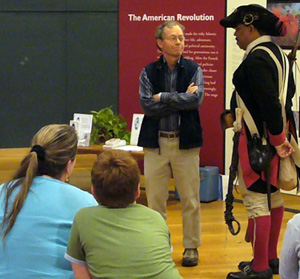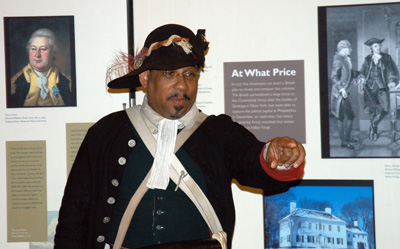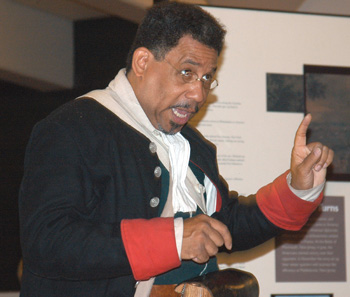
Park tells story of African-American soldiers
VALLEY FORGE, Pa.— Valley Forge offers a number of programs for its visitors. But the one that interested me the most was the “Quest for Freedom” presentation. The “Quest for Freedom” program is a part of the living history series.
The living history series are the reenactments of the lives of people and soldiers who played a vital part in the Revolutionary War. The person whose life was being presented on the day of my visit was Edward “Ned” Hector.
| Revolutionary War soldier Ned Hector, portrayed by actor Noah Lewis, talks to guests at the Valley Forge National Historical Park Visitor Center (Staff photos). |  |
“Ned” Hector was a teamster and artilleryman during the Revolutionary War. The thing that intrigued me the most was that “Ned” Hector was black.
Hector was born in 1744 and died in 1834. He was noted for his courage during the retreat from the battle of Brandywine, when he fought to keep his wagon and team from falling into the hands of the enemy.
This piece was performed by area resident Noah Lewis at the Visitor Center of Valley Forge National Historical Park here, just a short morning drive from downtown Philadelphia.
Dressed in his colonial garb, Lewis tells the story of “Ned” Hector and the how African-Americans contributed to the Revolutionary War in critical ways beyond being slaves, cooks and field hands. Lewis began doing these weekly presentations at Valley Forge to contribute to the history and to rid the stereotypes of blacks during the founding days of America.
“My attitude towards the Revolutionary War was all blacks were poor and all blacks were slaves. Why would I want to know anything about that?” Lewis said. “A lot of them feel the same way I did.”
Lewis went on to explain how blacks feel about their ancestors in the war.
 He began making these presentations when his daughter’s teacher approached him about doing a colonial presentation for her fifth grade class. Lewis was known for doing presentations on electricity and biology.
He began making these presentations when his daughter’s teacher approached him about doing a colonial presentation for her fifth grade class. Lewis was known for doing presentations on electricity and biology.
Although the presentation was focused on “Ned” Hector, a prominent black man in the Continental Army, it was a history lesson about the Revolutionary War itself. Hector explained how Washington did not allow blacks to join the army at first, but when no one else wanted to fight and his men were getting scarce and desperate, he began to let them fight.
Lewis captivated his audience by breaking character from time to time to compare and contrast instances during the war to today or to recent history.
He also encouraged the audience participate by pulling people out of the crowd to play certain characters and asking questions that required audience response.
“I feel that he does a really great job about bringing the character to life,” said Park Interpreter Agena Rogers.
Lewis taught the audience about certain period mannerisms and practices. One of the mannerisms that Lewis addressed through the character of Hector was how to approach a lady in the street.
“You would always ask permission of the gentleman she was with, whether it is her brother, father, husband, whoever. You wait for him to introduce her and then greet her with a bow or a kiss on the hand,” Lewis told the audience.
Lewis also explained how common words became apart of our language. Betty Nash, an audience member, said she was shocked to learn that such common words came in to being.
“I never knew that the word car was short for carriage,” Nash said.
Other lessons that Lewis taught was how such simple actions became determinants of class. Cotillions and balls were places where a young lady or young man could meet their future mate.
John Harrison, another audience member, said the presentation was informative.
 “It’s amazing how wearing gloves at balls was, so they would not be able to touch hands, due to their lack of proper hygiene,” Harrison said. “Now it’s common practice at these formal dances.”
“It’s amazing how wearing gloves at balls was, so they would not be able to touch hands, due to their lack of proper hygiene,” Harrison said. “Now it’s common practice at these formal dances.”
Lewis not only performs at Valley Forge, but he also gives presentations at local schools in the area.
The main point for Lewis doing his presentation is to get people to acknowledge the important that all of our ancestors had an important role in fighting for this country’s freedom.
“When you see a black person, think his people or her people helped us; for our country to be free,” Lewis said.
Other characters in the living history series are Hannah Till, one of George Washington’s cooks during the Revolution and members of the 1st Rhode Island Regiment, the first black regiment in the Revolutionary War.
The “Quest for Freedom” project is in conjunction with the Convention and Visitor’s Bureau at Valley Forge. It is a part of a bigger regional project with the surrounding counties.
If You Go
Operation and Seasons:
Park grounds open daily, year-round 6 a.m. to 10 p.m. Welcome Center 9 a.m. to 5 p.m. daily. Washington‘s Headquarters open 9 a.m. to 5 p.m. daily. Washington Memorial Chapel open 10 a.m. to 5 p.m. Monday through Saturday, 1 p.m. to 5 p.m. Sunday. Valley Forge Canteen open 10 a.m. to 2 p.m. Saturday and Sunday. Closed Thanksgiving, Christmas and New Year’s Day.
1400 Outerline Dr., King of Prussia, Pa. 19406, 610-783-1077, http://www.nps.gov/vafo/.
Directions:
From Philadelphia, New Jersey and points southeast, via I-76 Schuylkill Expressway west:
I-76 Schuylkill Expressway west to Exit 328A . Stay Right and merge onto U.S. 422 east.
Take Valley Forge exit onto Route 23 west. Turn right at exit ramp and merge to the center lane. Park entrance is straight through the first set of traffic lights (at intersection with North Gulph Road).
Parking: free parking lots surrounding the Visitor’s Center
Admission fee: free.
“Ned” Hector presentation Saturdays at 1 p.m. For more information about “Ned” Hector, visit http://www.nedhector.com.

Comments are Closed